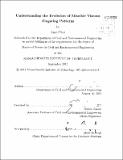Understanding the evolution of miscible viscous fingering patterns
Author(s)
Chui, Jane (Jane Yuen Yung)
DownloadFull printable version (4.290Mb)
Other Contributors
Massachusetts Institute of Technology. Dept. of Civil and Environmental Engineering.
Advisor
Ruben Juanes.
Terms of use
Metadata
Show full item recordAbstract
Viscous fingering, the hydrodynamic instability that occurs when a lower viscosity fluid displaces a higher viscosity fluid, creates complex patterns in porous media flows. Fundamental facets of the displacement process, such as volumetric sweep and mixing efficiency, depend strongly on the type of pattern created by the uneven front of the less viscous fluid. The interface created from these fingering patterns affects mixing, and therefore understanding how these patterns evolve is of critical importance in applications such as enhanced oil recovery and groundwater remediation. We use a Hele-Shaw cell to study experimentally how changing three parameters the injection rate, the viscosity contrast between the two fluids, and the gap thickness through which the fluid flows -- affects the resulting fingering pattern. The results lead to some basic observations, such as finger widths increasing uniformly with gap thickness, or that increasing the mobility ratio leads to more and narrower fingers. However, this systematic experimental method also uncovered an unexpected trend: non-monotonic finger width behavior with respect to injection rate. This non-monotonicity was observed for all mobility ratios and gap thicknesses, and is summarized in the experimental phase diagram created. To further understand how a viscous fingering pattern evolves over time, we also calculate the interface growth of a pattern over time using image analysis. This analysis shows that the interface moves through three self-similar regimes over time, and suggests that viscous fingering only actively adds interfacial length for a certain period of time in a pattern's growth. Both of these findings impact how much interfacial area a fingering pattern can create, and developing a better understanding of the evolution of miscible viscous fingering patterns is necessary for being able to accurately determine the mixing efficiency of a fingering pattern.
Description
Thesis (S.M.)--Massachusetts Institute of Technology, Dept. of Civil and Environmental Engineering, 2012. Cataloged from PDF version of thesis. Includes bibliographical references (p. 41-42).
Date issued
2012Department
Massachusetts Institute of Technology. Department of Civil and Environmental EngineeringPublisher
Massachusetts Institute of Technology
Keywords
Civil and Environmental Engineering.